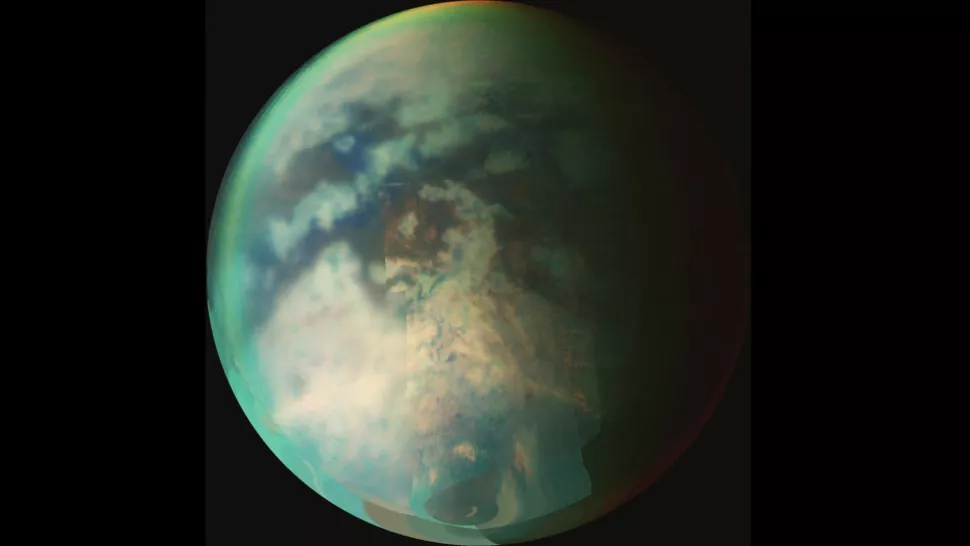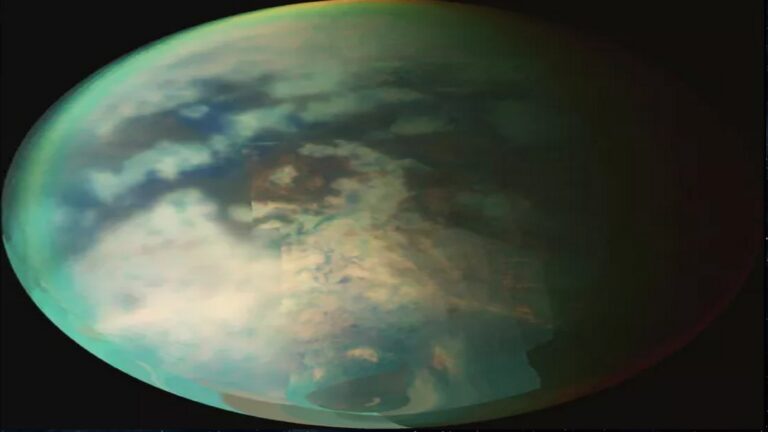The movement of subsurface oceans on Saturn’s moon Titan is affected by the icy crust surrounding it.
Saturn’s largest moon Titan is an intriguing world that looks a bit like Earth but not quite so.
Titan, a moon of Saturn, is a peculiar celestial body that has been meticulously studied by NASA’s Cassini mission and other spacecraft. Its extremely low temperatures result in the formation of lakes and seas composed of liquid methane and ethane on its surface. However, beneath the hard and icy outer shell made of water, lies a vast ocean of liquid water that could possibly support life.
A group of researchers from the Catholic University of Louvain (UCLouvain) in Belgium is seeking to comprehend the interactions between the subsurface ocean and the icy covering that encases it. In particular, they aim to gain a better understanding of how the ocean’s depth and the pressure exerted by the ice shell affect the development of tidal movements and currents within it.

Drawing from a wealth of earlier research on Titan’s subsurface ocean, the team of researchers leveraged a cutting-edge numerical model called SLIM (Second-generation Louvain-la-Neuve Ice-ocean Model). This model has previously been employed to explore the methane lakes and seas that cover Titan’s surface. In their investigation, the researchers delved into both two- and three-dimensional facets of the subsurface ocean using a simulated model of a 60-mile-deep (100 kilometers) ocean to simulate the mechanisms taking place in the water body.
The researchers also analyzed the gyres present on Titan, which are large systems of rotating ocean currents that are also found on Earth, with the latter boasting five main gyres. In comparison, Titan, which is larger than Mercury, the smallest planet in the solar system, appears to only have two gyres.
While the tides in Earth’s oceans are affected by the gravitational pull of the moon, tidal movements on other celestial bodies, such as Titan with its internal liquid oceans, are influenced by different factors, such as the depth of the subsurface ocean and the presence of an outer ice shell that exerts pressure on the internal ocean, creating tides, currents, and gyres. This prompts the question: how does Titan’s ice shell impact the tidal movements of its subsurface ocean?
According to Robert Tyler, a research scientist at NASA’s Goddard Space Flight Center and an associate research scientist at the University of Maryland Baltimore County, who co-authored the study, the behavior of the internal ocean is determined by the stiffness of the ice crust and the viscosity of the ice interacting with the ocean.
“The stiffness of the ice creates a new ice [and] ocean wave mode that can travel faster than the ocean waves without ice,” Tyler wrote. “It also creates dispersion (wave speeds vary with wavelength). [Then], the viscosity of the ice layer damps the waves.”
In essence, the varying stiffness and thickness of Titan’s ice shell play a significant role in shaping the tidal movements and gyres on a global scale. Unlike the ocean currents on Earth, which move around the globe, gyres on Titan remain stationary and drive water circulation in specific areas. The two gyres on Titan rotate simultaneously around the moon’s poles.
To create their models, the researchers relied on a combination of previous calculations and studies of high-latitude oceans on Earth. However, the study has its limitations since the exact depth of Titan’s subsurface ocean is not known.
David Vincent, the lead author of the study and a research assistant in environmental sciences at UCLouvain, explained in an email to Space.com that while the study explored how the ocean’s depth affects tidal movements, “no conclusion on the depth of the ocean can be drawn from my results.” Vincent referred to other ocean worlds in the solar system, including Enceladus, Saturn’s smaller moon, and Europa, one of Jupiter’s moons, noting that while their oceans are approximately 62 miles (100 kilometers) deep, the “difference in depth and size can result in various phenomena taking place,” citing Enceladus’ geysers as an example.
Both Vincent and Tyler noted NASA’s Dragonfly mission to Titan as a potential next step in exploring the moon. However, Vincent pointed out that the mission will not specifically target the subsurface ocean but will instead investigate the electric fields, which may provide some clues about the ocean’s depth. The Dragonfly mission is scheduled to launch in 2027 and arrive at Titan in 2034.
“Future studies should either use new analysis methods of Cassini’s data or use models,” Vincent added. “Regarding ocean modeling, the next step could consist in improving the modelisation of 3D phenomena related to temperature and ‘salinity’ and study their interaction with the tidal motion.”
The study is described in a paper published in December 2022 in the journal Icarus.
Do not forget to share your opinion with us to provide you with the best posts !




0 Comments